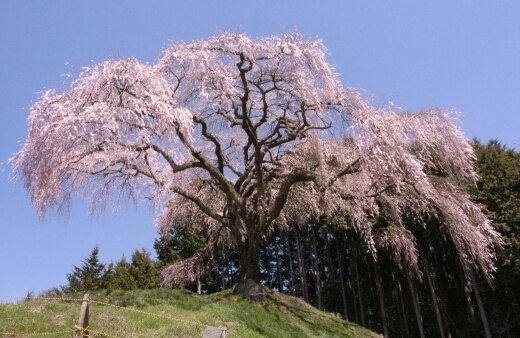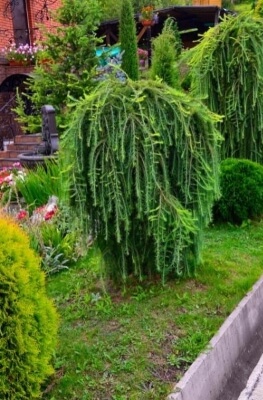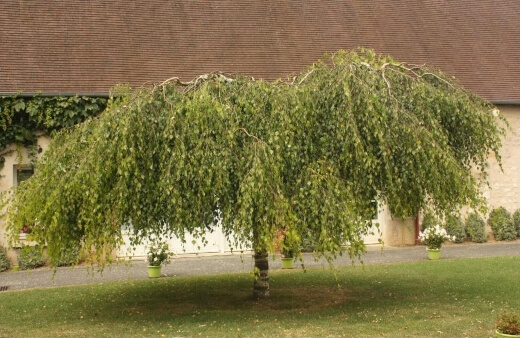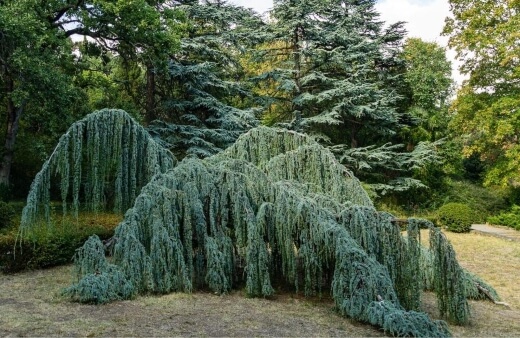Weeping trees are quite unusual yet mesmerizing. Delicate branches falling down from the trunk like water dripping down, these trees are sought-after gems in gardens and yards all over the world.
Adding a weeping tree to your landscape, whether it be a flowering, evergreen, or deciduous kind, gives a striking focal point to the design. In this article, we have listed eight beautiful weeping trees you can plant in your small garden or yard effortlessly to add that oomph your yard needs.
More...
Best Weeping Trees to Grow in Australia
1. Weeping Cherry Tree (Prunus pendula ‘Pendula Rosea’)

There aren't many weeping trees with noticeable flowers, but you will be taken aback by the weeping cherry tree. Prunus pendula ‘Pendula Rosea’ or weeping cherry trees flourish in full sun to partial shade and are hardy to -28°C. They can grow up to 25 feet tall and spread out over a wide area.
If you want the beauty of weeping cherry trees but don't have that much space, you can go for dwarf weeping trees such as the dwarf weeping cherry trees. They grow to 8-10 feet in height and only need watering 1-3 times per week!
The springtime beautiful pink blooms of Prunus ‘Pendula Rosea’ remain for one to two weeks. This Asian native's very attractive shoots are frequently planted onto a straight stem to create an umbrella-like shape.
If the tree develops non-weeping branches that grow straight up from the grafting place, remove them right away.
Check out our guide on Weeping Cherry Trees and the best varieties to grow in Australia.
2. Weeping Hemlock (Tsuga canadensis ‘Pendula’)

If you are a fan of hemlocks, you might consider weeping hemlocks if you lack the space to cultivate the large hemlock trees. Tsuga canadensis ‘Pendula’ or weeping hemlocks, is a good alternative for tiny gardens because of their lower size (five feet in height with a ten-foot spread) and downward-growing branches.
Weeping hemlocks grow small, brown cones and are evergreen plants that do well in normal soil conditions and full to moderate shade. Their form and shape rely on the training and pruning given to the tree when it was young.
Another common cultivar name for weeping hemlock in commerce is Tsuga canadensis ‘Sargentii’. Resistant to -34°C.
3. Japanese Crimson King (Acer platanoides ‘Crimson King’)

Acer platanoides ‘Crimson King’, also known as the Japanese maple cultivar known as Crimson King, has branches that arch downward from the stem to the ground and a pyramid, weeping growth habit.
There are other Japanese maple kinds with a comparable growth pattern, but Acer platanoides ‘Crimson King’ is my personal favorite because of its maroon, highly edged leaves that turn a beautiful scarlet in the fall.
‘Crimson Queen’ is a fantastic alternative. In warm climates, pick a spot that is just a little bit shaded. Pick full sunshine if you're in a cooler climate. They grow up to 8-10 feet in height and are hardy down to –28°C.
Be sure to check out our guide on growing Japanese maple if you are interested in adding some colour to your garden.


Get Your Free Guide:
Master Growing Australian Natives eBook
A Must Have Complete Guide for Every Australian Garden
Get Your Free Guide:
Master Growing Australian Natives eBook
A Must Have Complete Guide for Every Australian Garden
4. Weeping Larch (Larix decidua ‘Pendula’)

Larix decidua ‘Pendula’ or weeping larch, is distinctive in that it is a deciduous tree with needles. Along the pendulous branches of this plant are tufts of green needles.
The leaves turn a vivid yellow in the autumn and eventually fall off the shrub. Down to -40°C, weeping larch can survive the winter. They may be trained into unusual shapes and forms and develop quickly.
Another excellent option is the Japanese weeping larch (Larix kaempferi ‘Pendula’). Weeping larch trees are real show-stoppers thanks to their delicate appearance and lofty, mound-like construction. They are ten feet broad and eight to twelve feet tall.
5. Weeping Birch (Prunus betula ‘Youngii’)

Prunus betula ‘Youngii’ or Young's weeping birch, is a beautiful tiny tree that may be trained to bend and form a pile of greenery on its trunk. These deciduous weepers can withstand cold temperatures of -20 °C and grow neither slowly nor quickly.
They are 15 feet broad and up to 10 feet tall. In the spring, tiny yellow catkins are produced, which cover the bare branches in fluffy, unassuming blossoms. Grafting Young's weeping birch frequently results in an umbrella-like form.
The drooping branches have the potential to extend all the way to the ground. The autumnal color of the teardrop-shaped green leaves is a gorgeous yellow.
6. Weeping Nootka Cypress (Callitropsis nootkatensis ‘Pendula’)

Nootka cypress trees are among the largest and most impressive weeping evergreen trees. These elegant trees will grow a maximum of 35 feet tall, making them difficult to miss.
They do best in full sun and can grow in any type of soil. This weeping evergreen is a cultivar of a species that is native to the United States and the Canadian West Coast. It is pyramidal in shape and grows slowly.
Flattened sprays of leafy foliage with needle-like edges cover the sagging branches. It thrives naturally in cooler areas and is largely free of pests and diseases.
7. Weeping Redbud Tree (Canadensis cercis)

Cercis canadensis or weeping redbuds come in a few common kinds, but Cercis canadensis ‘Ruby Falls’ stands out for its burgundy-red leaves. Small gardens are ideal for this variety of trees native to North America.
The springtime, you'll see heart-shaped leaves grow as the pinkish-purple flowers start to shed. Weeping redbuds benefit from full to partial sun. The Cercis canadensis ‘Ruby Falls’ grows up to eight feet in height and has a spread of five to six feet. It is winter hardy down to -15°C.
Although it has green foliage, the lavender twist is another kind of weeping redbud you can opt for.
8. Weeping Blue Atlas Cedar (Cedrus atlantica ‘Glauca’)

Cedrus atlantica ‘Glauca’, or blue atlas cedar, is a beautiful specimen that is more likely to prompt inquiries from people visiting your garden than any other plants or trees. Along the stems, there are tuft-like groups of blue needle clusters.
Blue atlas cedars grow up to 60 feet tall and have an amazing, arching spread of up to 40 feet. They are hardy to -20°C to -15°C. These weeping trees mature into the most amazing specimens.
They are evergreen and have long, spreading branches. The boughs look to be curtains as they fall to the ground.
Bonus: Check out our Weeping Lilly Pilly Native Growing Guide
Wrapping Up Our Weeping Trees List
Weeping trees are perfect for gardens and backyards, and there are so many varieties that you will definitely find the right pick for you, may it be in your preferable size, ease of maintenance, or beauty.
So if you are a tree-lover, don't miss these eight beautiful weeping trees to plant in your garden.
Published on July 23, 2022 by Lorri Hopkins
Last Updated on February 7, 2024




